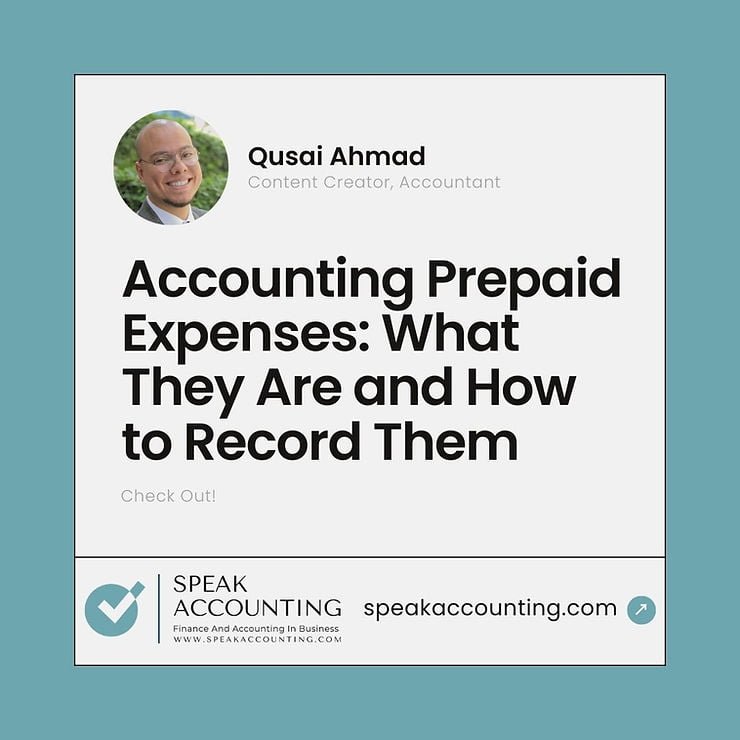Prepaid expenses in accounting refer to the goods or services that a business pays for in advance, but will only receive or consume in the future. These expenses are also called prepaid costs, prepaid expenditures, or prepayments.
Accounting prepaid expenses are an important part of accounting because they affect the income statement, the balance sheet, the cash flow statement, and the tax liability of a business. Accounting prepaid expenses also help managers to plan, control, and evaluate the cash flow and working capital of a business.
In this blog post, we will discuss the definition and examples of accounting prepaid expenses and how to record them.
What You Will Learn
By reading this blog post, you will learn:
- The difference between accounting prepaid expenses and accounting accrued expenses.
- The common examples of accounting prepaid expenses, such as rent, insurance, subscriptions, and supplies.
- The accounting treatment of accounting prepaid expenses, including the journal entries, the adjusting entries, and the financial statements.
Accounting Prepaid Expenses vs Accounting Accrued Expenses
Before we dive into the definition and examples of accounting prepaid expenses, let’s clarify the difference between accounting prepaid expenses and accounting accrued expenses.
Both accounting prepaid expenses and accounting accrued expenses refer to the timing difference between when an expense is paid and when it is recognized. However, they have opposite meanings and implications in accounting.
Accounting prepaid expenses are the expenses that are paid before they are incurred. Accounting prepaid expenses are recorded as assets in the balance sheet and are expensed in the income statement over the period of benefit.
Accounting accrued expenses are the expenses that are incurred before they are paid. Accounting accrued expenses are recorded as liabilities in the balance sheet and are expensed in the income statement in the period of occurrence.
For example, suppose a business pays $12,000 for a one-year insurance policy on January 1, 2020. This is an accounting prepaid expense, as the business pays for the insurance before it receives the benefit. The business records the payment as a prepaid insurance asset in the balance sheet and amortizes the asset as an insurance expense in the income statement over the 12 months of 2020.
On the other hand, suppose a business receives a $1,000 electricity bill on January 31, 2020 for the electricity consumed in January 2020. This is an accounting accrued expense, as the business incurs the electricity expense before it pays for it. The business records the expense as an electricity expense in the income statement and a accrued electricity liability in the balance sheet in January 2020.
The Common Examples of Accounting Prepaid Expenses
Accounting prepaid expenses can arise from various types of transactions and events that involve the advance payment for goods or services that will be received or consumed in the future. Some of the common examples of accounting prepaid expenses are:
- Rent: Rent is the amount of money that a business pays to use a property or a space for a specified period of time. Tenants typically pay rent at the start of the rental period, whether it’s monthly, quarterly, or annually.
Therefore, rent is an accounting prepaid expense, as the business pays for the rent before it uses the property or the space. For example, if a business pays $3,000 for a three-month rent on January 1, 2020, the business records the payment as a prepaid rent asset in the balance sheet and recognizes the rent expense in the income statement over the three months of 2020 - Insurance: Insurance is the amount of money that a business pays to an insurance company to protect itself from the risk of loss or damage. Insurance is usually paid in advance for a specified period of coverage, such as monthly, quarterly, or annually.
Therefore, insurance is an accounting prepaid expense, as the business pays for the insurance before it receives the benefit. For example, if a business pays $12,000 for a one-year insurance policy on January 1, 2020, the business records the payment as a prepaid insurance asset in the balance sheet and amortizes the asset as an insurance expense in the income statement over the 12 months of 2020. - Subscriptions: Subscriptions are the amount of money that a business pays to access or use a service or a product for a specified period of time. Subscriptions are usually paid in advance for a specified period of access or use, such as monthly, quarterly, or annually.
Therefore, subscriptions are accounting prepaid expenses, as the business pays for the subscriptions before it accesses or uses the service or the product. For example, suppose a business pays $600 for a one-year subscription to an online software on January 1, 2020. In that case, the business records the payment as a prepaid subscription asset in the balance sheet and recognizes the subscription expense in the income statement over the 12 months of 2020. - Supplies: Supplies are the amount of money that a business pays to purchase or acquire the goods or materials that are used in the normal course of business operations. Supplies are usually paid at the time of purchase or acquisition, but they are not consumed or used immediately. Therefore, supplies are accounting prepaid expenses, as the business pays for the supplies before it consumes or uses them.
For example, if a business pays $500 for office supplies on January 1, 2020, the business records the payment as a prepaid supplies asset in the balance sheet and recognizes the supplies expense in the income statement as the supplies are consumed or used during 2020.
The Accounting Treatment of Accounting Prepaid Expenses
Accounting prepaid expenses are treated as assets in the balance sheet and are expensed in the income statement over the period of benefit. The accounting treatment of accounting prepaid expenses involves two steps: the journal entry at the time of payment and the adjusting entry at the end of the period.
The Journal Entry at the Time of Payment
The journal entry at the time of payment is the entry that records the payment of the accounting prepaid expense and the creation of the prepaid asset. The journal entry at the time of payment has the following format:
Table
| Debit | Credit |
| Prepaid Expense (Asset) | Cash (Asset) |
The debit to the prepaid expense account increases the prepaid asset in the balance sheet. The credit to the cash account decreases the cash asset in the balance sheet.
For example, if a business pays $12,000 for a one-year insurance policy on January 1, 2020, the journal entry at the time of payment is:
Table
| Accounts | Debit | Credit |
| Prepaid Insurance (Asset) | $12,000 | |
| Cash (Asset) | $12,000 |
The Adjusting Entry at the End of the Period
The adjusting entry at the end of the period is the entry that records the recognition of the expense and the reduction of the prepaid asset. The adjusting entry at the end of the period has the following format:
Table
| Debit | Credit |
| Expense (Expense) | Prepaid Expense (Asset) |
The debit to the expense account increases the expense in the income statement. The credit to the prepaid expense account decreases the prepaid asset in the balance sheet.
For example, if a business pays $12,000 for a one-year insurance policy on January 1, 2020, the adjusting entry at the end of each month of 2020 is:
Table
| Accounts | Debit | Credit |
| Insurance Expense (Expense) | $1,000 | |
| Prepaid Insurance (Asset) | $1,000 |
Conclusion
Accounting prepaid expenses are the expenses that are paid in advance by a business for goods or services that will be received or consumed in the future. Accounting prepaid expenses are recorded as assets in the balance sheet and are expensed in the income statement over the period of benefit.
By understanding the definition and examples of accounting prepaid expenses and how to record them, you can improve your accounting skills and financial literacy, as well as the management and performance of your business.
We hope that this blog post has helped you understand and appreciate the accounting prepaid expenses and how to record them. If you have any questions or comments, please feel free to leave them below. Thank you for reading and happy learning! 😊




